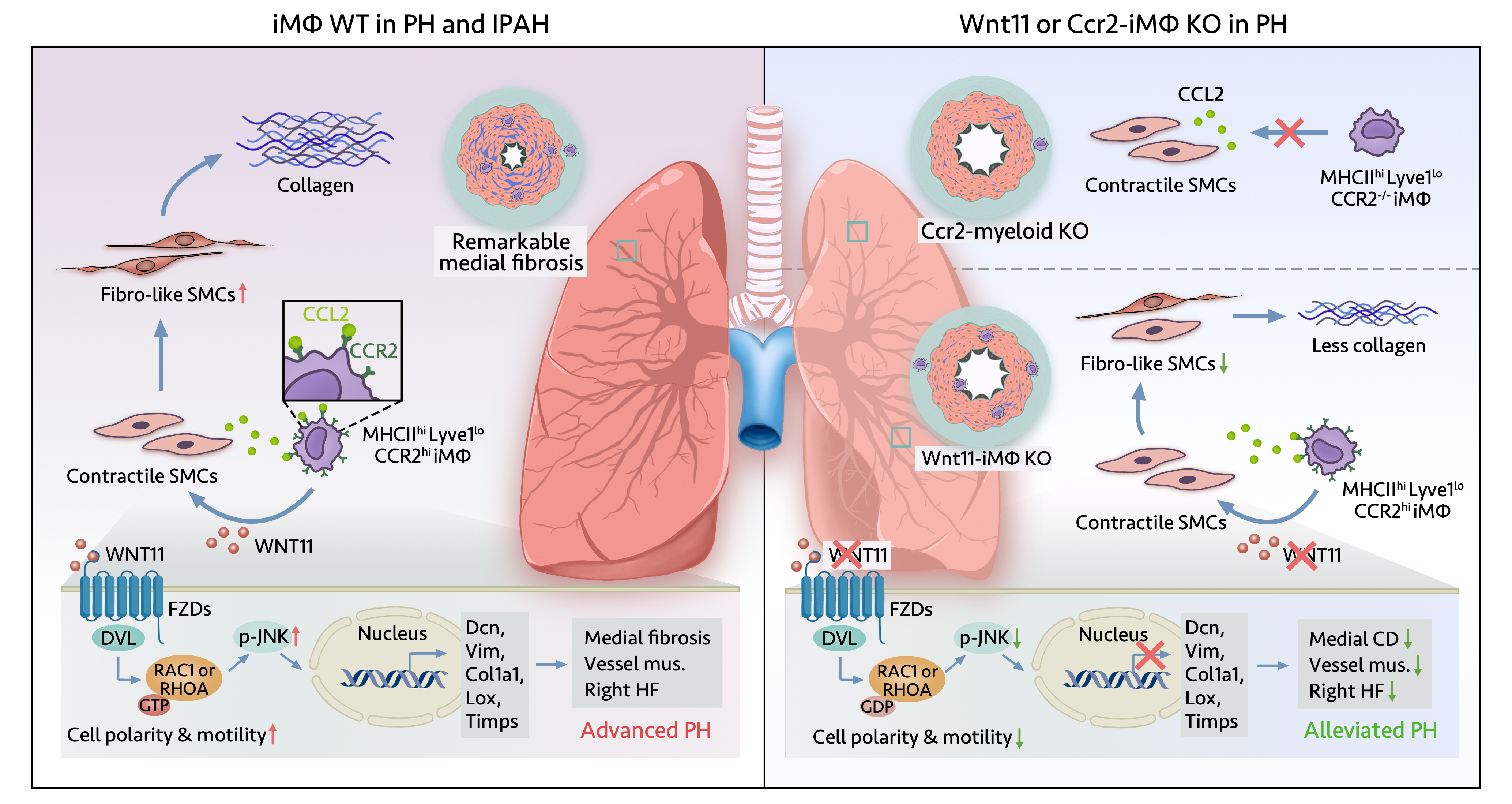Final ID: Su4175
MHCIIhiLYVE1loCCR2hi Interstitial Macrophages Promote Medial Fibrosis in Pulmonary Arterioles and Contribute to Pulmonary Hypertension
Abstract Body (Do not enter title and authors here): Background: Pulmonary hypertension (PH) is a lethal disease characterized in part by progressive pulmonary arteriole (PA) remodeling. Excessive PA fibrosis and macrophage infiltration are often present in PH, but potential association is obscure. We invesitgated the link between interstitial macrophage (iMΦ) infiltration and PA fibrosis in PH and idiopathic pulmonary arterial hypertension (IPAH).
Methods: Lung tissue samples from patients with IPAH (n=11) and experimental PH (sugen-5416 and hypoxia, hypoxia, or monocrotaline, n=5) animals (adult male and female SD rats) were obtained to analyze the extent of fibrosis in PA adventitia and media and their correlation to disease severity. Single-cell RNA sequencing, immunohistological analyses, iMΦs and PA smooth muscle cells (PASMCs) coculture, and transgenic animal experiments were used to investigate the cell heterogeneity and molecular mechanisms by which iMΦs promote PA medial fibrosis. Data in this study were analyzed with unpaired two-tailed t-tests with Welch’s correction, Kruskal-Wallis one-way ANOVA followed by Dunn’s test, RM ANOVA with Geisser-Greenhouse correction, or Pearson correlation test, and p < 0.05 was considered statistically significant.
Results: We found that increased collagen deposition and fibrosis in the PA media were correlated with PH severity, and iMΦ medial infiltration may be involved in these pathological processes. Single-cell transcriptomics suggested that ligand-receptor associations between MHCIIhiLYVE1loCCR2hi iMΦ and fibroblast-like vascular SMC subclusters contributed to PA medial fibrosis. Mechanistically, MHCIIhiLYVE1loCCR2hi iMΦs regulated PASMC phenotypic transition and collagen production through the wingless member 11 (WNT11)/planar cell polarity (PCP) pathway. Deletion of iMΦ-enriched Wnt11 in myeloid cells of PH rats (ItgamCreERT2; Wnt11fl/fl) normalized the fibrotic PASMC phenotype and decreased PA medial fibrosis, thereby protecting against PH. Moreover, myeloid-specific C-C motif chemokine receptor 2 (Ccr2) deficiency (ItgamCreERT2; Ccr2fl/fl) in PH-PAs inhibited MHCIIhiLYVE1loCCR2hi iMΦ infiltration.
Conclusions: PA medial fibrosis is a causative factor of PH, and the inhibition of MHCIIhiLYVE1loCCR2hi iMΦ pathogenicity or infiltration reverses PA medial fibrosis and thus alleviates PH.
Methods: Lung tissue samples from patients with IPAH (n=11) and experimental PH (sugen-5416 and hypoxia, hypoxia, or monocrotaline, n=5) animals (adult male and female SD rats) were obtained to analyze the extent of fibrosis in PA adventitia and media and their correlation to disease severity. Single-cell RNA sequencing, immunohistological analyses, iMΦs and PA smooth muscle cells (PASMCs) coculture, and transgenic animal experiments were used to investigate the cell heterogeneity and molecular mechanisms by which iMΦs promote PA medial fibrosis. Data in this study were analyzed with unpaired two-tailed t-tests with Welch’s correction, Kruskal-Wallis one-way ANOVA followed by Dunn’s test, RM ANOVA with Geisser-Greenhouse correction, or Pearson correlation test, and p < 0.05 was considered statistically significant.
Results: We found that increased collagen deposition and fibrosis in the PA media were correlated with PH severity, and iMΦ medial infiltration may be involved in these pathological processes. Single-cell transcriptomics suggested that ligand-receptor associations between MHCIIhiLYVE1loCCR2hi iMΦ and fibroblast-like vascular SMC subclusters contributed to PA medial fibrosis. Mechanistically, MHCIIhiLYVE1loCCR2hi iMΦs regulated PASMC phenotypic transition and collagen production through the wingless member 11 (WNT11)/planar cell polarity (PCP) pathway. Deletion of iMΦ-enriched Wnt11 in myeloid cells of PH rats (ItgamCreERT2; Wnt11fl/fl) normalized the fibrotic PASMC phenotype and decreased PA medial fibrosis, thereby protecting against PH. Moreover, myeloid-specific C-C motif chemokine receptor 2 (Ccr2) deficiency (ItgamCreERT2; Ccr2fl/fl) in PH-PAs inhibited MHCIIhiLYVE1loCCR2hi iMΦ infiltration.
Conclusions: PA medial fibrosis is a causative factor of PH, and the inhibition of MHCIIhiLYVE1loCCR2hi iMΦ pathogenicity or infiltration reverses PA medial fibrosis and thus alleviates PH.
More abstracts on this topic:
A Novel EMR-Based Algorithm with the Virtual Echocardiography Screening Tool (VEST) to Screen Patients for Pulmonary Arterial Hypertension
Narowska Gabriela, Anand Suneesh, Gangireddy Chethan, Enevoldsen John, Keane Martin, Edmundowicz Daniel, Forfia Paul, Vaidya Anjali
84 Immune checkpoint profiling in major aortic diseases leads to identification of potential roles of CD155-CD206 pathway in suppressing inflammation and immune responsesShao Ying, Saaoud Fatma, Xu Keman, Lu Yifan, Jiang Xiaohua, Wang Hong, Yang Xiaofeng

